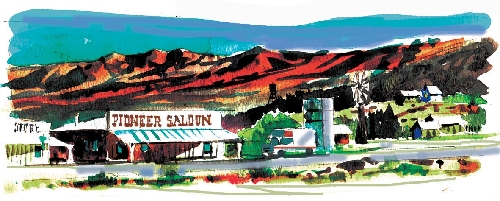Goodsprings a short drive with a long heritage
The smallest of the pioneer towns surviving in Clark County, Goodsprings, is about a half-hour's drive from Las Vegas, nestled near the southern Spring Mountain Range, a short trip into the region's past.
To reach the town of fewer than 200 people, head south from Las Vegas on Interstate 15. At the Jean exit, turn right onto Route 161. Goodsprings is seven miles west of Jean near the base of the mountains out of sight of the freeway. From Goodsprings, Route 161 continues west through scenic Columbia Pass to Sandy Valley, a scattered community along the Nevada-California border.
The highway parallels a historic travel route used by native cultures for centuries. Following ancient pathways linking watering holes across the desert, early explorer Antonio Armijo in 1830 visited the life-giving springs near the site of what would become Goodsprings. In the 1850s, when Mormon colonists established a fort along Las Vegas Creek and assessed the nearby mountains for mining, they also would have known about the water just south of their diggings near Mount Potosi.
The springs later took their name from Joseph Good, an early rancher and prospector who frequented the area. Discoveries of gold, silver, lead and zinc brought mining ventures to the region in the late 1860s. The town of Goodsprings would grow from rich gold discoveries in the 1890s.
In the early 1900s, a large mill processed ore from a variety of ventures in the area surrounding the town. In 1911, a railroad spur to haul ore connected Goodsprings with the main rail line through Jean, causing the mining community to boom.
By its heyday, the town reached a peak population of about 800 residents. During World War I, the mines around Goodsprings helped meet wartime demand for lead and zinc. By that time, Goodsprings boasted a variety of stores, saloons, a fine hotel, a hospital, a school, a newspaper and a post office.
The mill's foundations lie along the highway before you reach Goodsprings. The town's cemetery, opposite the mill ruins, overlooks the peaceful desert and distant mountains. The earliest grave dates to 1890. A few fences delineate family plots. Fine monuments bear the names of early residents who were prominent in the development of Southern Nevada, including George Fayle, a businessman who built the two-story hotel and the Pioneer Saloon, and Norman Price, who built the Goodsprings School.
The ore mill was long ago dismantled. The hotel fell victim to fire decades ago. The railroad spur disappeared in the 1930s. Most of the buildings from early Goodsprings are gone, with a few notable exceptions. Visitors cruising the little town's grid of streets see a few survivors. The styles of some of the residences obviously date from earlier decades. A small, one-story stone structure is the town's earliest building, dating from 1886. One wooden cabin stands near a venerable cottonwood that was big enough to give it shade when it was built in 1910.
Two buildings from yesteryear stand on the main street two blocks apart. The Pioneer Saloon and the Goodsprings Schoolhouse both turn 100 this year. The saloon is Clark County's oldest drinking establishment, while the Goodsprings Schoolhouse is the oldest school in Clark County and one of the oldest in Nevada still in operation.
The saloon boasts original pressed metal panels coverings the walls and ceiling inside, while outside panels look like stone blocks. The cherry wood bar was moved from Rhyolite to Goodsprings. The saloon's collection of photos and documents forms a small museum. It includes coverage of the January 1942 plane crash near Mount Potosi that killed actress Carole Lombard, among others. Her husband, movie star Clark Gable, waited in the saloon for word about the crash.
The Goodsprings Schoolhouse is listed on the National Register of Historic Places. Originally a one-room school, the building was expanded in 1916 and remodeled several times during its decades of service.
Margo Bartlett Pesek's column appears on Sundays.






















